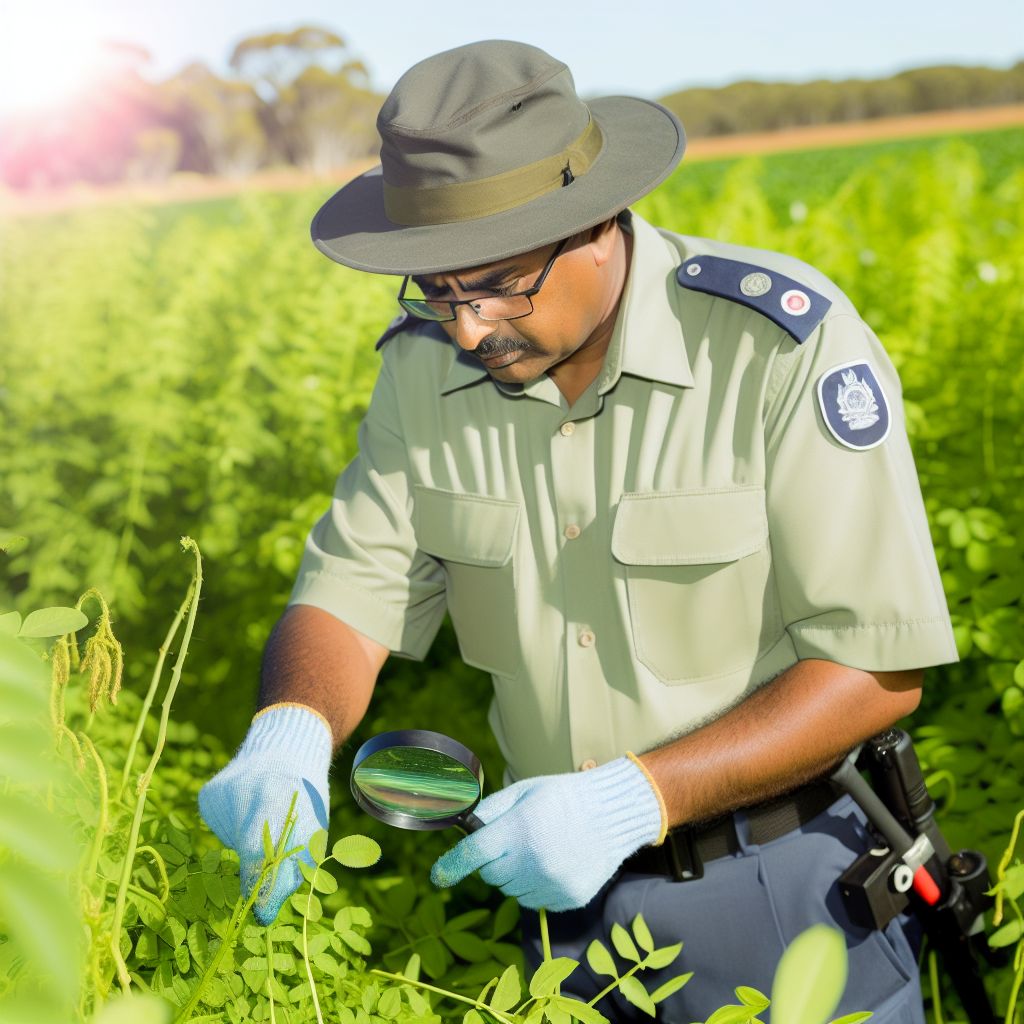Overview of Australia’s Biosecurity Framework
Protecting Agriculture Through Comprehensive Measures
Australia has a robust biosecurity framework to protect its unique agriculture sector.
This framework prevents the introduction and spread of harmful invasive species.
Consequently, it safeguards the country’s food supply and farming industries.
Biosecurity efforts focus on controlling pests, diseases, and weeds that threaten crops and livestock.
Moreover, these measures help maintain Australia’s clean and green agricultural reputation.
The Department of Agriculture and Fisheries leads national biosecurity policies and programs.
They collaborate closely with state governments and industry stakeholders across the country.
Private companies such as Southern Cross Biosecurity Services support on-ground monitoring and response activities.
Farmers and agricultural workers also play a critical role in early detection and reporting.
Key Components of the Biosecurity Framework
The framework includes strict border controls at airports, seaports, and mail centers.
Inspection and quarantine protocols help catch risks before they reach Australian soil.
Additionally, research institutions like the National Biosecurity Institute develop innovative detection tools.
Emergency response teams act quickly to contain outbreaks of invasive species and diseases.
Education campaigns increase public awareness about biosecurity risks and best practices.
The integration of technology, such as remote sensing and data analytics, improves threat tracking.
Your Personalized Career Strategy
Unlock your potential with tailored career consulting. Get clear, actionable steps designed for your success. Start now!
Get StartedThis coordination between agencies ensures swift action to protect agricultural assets.
Significance of Biosecurity for Australian Agriculture
Agriculture contributes significantly to Australia’s economy and employment.
Therefore, protecting farms from invasive pests and diseases is essential.
Biosecurity safeguards crop yields, livestock health, and export market access.
For example, preventing the introduction of fruit flies preserves fruit industries across regions.
Furthermore, these protections help Australia meet international trade standards.
Maintaining biosecurity supports sustainable agricultural growth and rural community resilience.
Ultimately, it shields the nation’s food security from emerging global threats.
Key Roles and Responsibilities in Biosecurity Jobs Across Australia
Frontline Biosecurity Officers
Frontline biosecurity officers monitor Australia's borders to detect invasive species.
They inspect cargo, mail, and passenger luggage for banned materials.
These officers ensure that harmful pests do not enter the country.
Moreover, they collaborate with customs and quarantine agencies regularly.
For example, Emily Harrington works at Brisbane Airport as a frontline officer.
Field Surveillance and Pest Management Specialists
Field surveillance specialists conduct regular checks on farms and natural areas.
Stand Out with a Resume That Gets Results
Your career is worth more than a generic template. Let us craft a resume and cover letter that showcase your unique strengths and help you secure that dream job.
Get HiredThey identify early signs of pest infestations or disease outbreaks.
Such specialists also implement eradication or containment strategies.
Often, they work with state agricultural departments and local farmers.
Lucas Bennett manages surveillance programs in Victoria's agricultural zones.
Laboratory Analysts and Diagnostic Technicians
Laboratory analysts examine samples brought in by field teams.
They diagnose diseases and verify the identity of pests accurately.
These technicians support decision-making through scientific testing.
Furthermore, they maintain strict biosecurity protocols within the labs.
At the Sydney Biosecurity Centre, Jessica Lin oversees diagnostic testing.
Policy Developers and Biosecurity Strategists
Policy developers create frameworks to strengthen Australia's biosecurity measures.
They analyze data from field operations to update regulations effectively.
These strategists work closely with government agencies and industry partners.
Additionally, they anticipate emerging threats from global trade trends.
Michael O'Connor leads policy development in Canberra, focusing on invasive species.
Transform Your LinkedIn for Maximum Impact
Elevate your professional brand with a LinkedIn profile that attracts recruiters, showcases your expertise, and maximizes opportunities. Stand out in your industry with a profile built for success.
Boost ProfileEducational and Community Engagement Officers
Educational officers raise awareness about biosecurity risks among the public.
They organize workshops and distribute informational materials nationwide.
Community engagement officers promote best practices for farmers and travelers.
They foster cooperation between local communities and biosecurity authorities.
Sarah Patel coordinates outreach programs throughout Queensland's rural regions.
Collaboration and Continuous Improvement
All biosecurity roles require close collaboration to protect agriculture efficiently.
Regular training ensures staff stay updated on new threats and technologies.
Leadership encourages innovation to improve detection and response efforts.
Together, these professionals form Australia's frontline defense against invasive species.
Types of Invasive Species Threatening Australian Agriculture
Invasive Plants and Their Impact
Invasive plants disrupt native ecosystems and outcompete valuable crops.
For example, prickly acacia spreads rapidly across grazing lands.
This plant reduces pasture quality and causes economic losses for farmers.
Moreover, invasive weeds like parthenium consume water resources needed by crops.
These plants also increase control costs for agricultural businesses.
Invasive Insects Affecting Crop Health
Several invasive insects threaten Australia's agricultural output.
The red imported fire ant damages farm infrastructure and harms livestock.
Additionally, the tomato potato psyllid spreads diseases that devastate crops.
Farmers also battle fruit flies that reduce fruit quality and marketability.
Effective surveillance is crucial to detect and manage insect invasions.
Invasive Animals and Their Risks
Invasive animals cause significant damage to farmland and native species.
Feral pigs uproot soil and consume crops, affecting yields negatively.
Rabbits also compete with livestock for pasture and degrade the land.
Similarly, cane toads threaten native wildlife and disrupt ecological balance.
Control programs target these animals to protect agricultural productivity.
Fungal and Microbial Threats to Agriculture
Invasive fungal pathogens cause diseases that reduce crop resilience.
For instance, rust fungi attack wheat, lowering grain quality and volume.
Phytophthora species cause root rot in various plants, leading to losses.
Biosecurity teams monitor for these microbes to prevent widespread outbreaks.
Early detection helps minimize damage from fungal infections.
Find Out More: How Zoologists Study and Protect Australian Wildlife
Skills and Qualifications Required for a Career in Biosecurity
Educational Background
A strong foundation in biology is essential for biosecurity roles.
Most employers prefer candidates with degrees in agriculture.
They also accept degrees in environmental science or zoology.
Additionally, courses in microbiology increase job prospects.
Courses in ecology also improve employment opportunities.
Practical knowledge of plant pathology is highly valued.
Knowledge of entomology is similarly important.
For example, Anna Mitchell studied environmental science.
She now works at EarthGuard Biosecurity Services.
Technical and Practical Skills
Biosecurity professionals must identify pests accurately.
They also identify invasive species accurately.
They routinely use diagnostic tools to analyze samples.
Laboratory techniques are important in sample analysis.
Moreover, fieldwork skills such as surveying are critical.
Specimen collection is a vital practical fieldwork skill.
Proficiency in computer-based data management is important.
This skill helps track incidents and control measures efficiently.
For instance, Jason Lee applies GIS technology in pest monitoring.
He uses these tools to track outbreaks effectively.
Soft Skills and Personal Attributes
Strong communication skills enable clear reporting.
They also aid effective team collaboration.
Attention to detail is vital to detect early signs of threats.
Problem-solving ability helps develop rapid response strategies.
Flexibility is important as field conditions can change unpredictably.
Resilience supports working under pressure during emergencies.
Certifications and Professional Development
Obtaining certifications in biosecurity practices enhances career opportunities.
Short courses in quarantine procedures are advantageous.
Courses in pest control also improve employment chances.
Continuing education helps professionals stay updated with threats.
Organizations like the Australian Biosecurity Association offer training programs.
For example, Claire Thompson earned certification qualifying her for senior roles.
She now works as a senior biosecurity analyst.
Experience and Career Pathways
Entry-level positions often require internships in related fields.
Volunteer experience is also valuable in the biosecurity sector.
Working with agricultural departments provides practical knowledge.
Environmental NGOs also offer relevant work experience.
Advancing depends on demonstrated expertise and leadership skills.
Many officers gain experience through cross-agency collaborations.
Lucas Grant progressed from field officer to team leader.
He now leads at Southern Biosecurity Solutions.
See Related Content: How Astronomers Explore the Universe from Australian Observatories
Daily Tasks and Challenges Faced by Biosecurity Professionals
Routine Inspections and Monitoring
Biosecurity officers perform regular inspections across farms, ports, and border checkpoints.
They examine incoming goods to detect invasive species or contaminants early.
Moreover, they monitor wildlife and plant health to identify potential biosecurity threats.
Daily inspections require keen observation and thorough documentation.
Officers like Emma Lawson work closely with farmers to ensure compliance with biosecurity laws.
Responding to Biosecurity Incidents
When invasive species are detected, professionals act immediately to contain outbreaks.
They coordinate with local authorities and agricultural experts to launch rapid responses.
For example, Dr. Marcus Ng led a team that quickly contained a pest infestation in Queensland.
These responses involve surveys, quarantines, and sometimes eradication measures.
Time-sensitive decisions greatly affect the success of containment efforts.
Collaboration and Community Engagement
Biosecurity specialists regularly engage with landowners and community groups.
They educate the public about preventing the spread of invasive species.
Furthermore, they build partnerships with industry bodies like Agrisafe Australia.
Field officers such as Claire Mitchell host workshops and field days to raise awareness.
Effective communication skills are essential for fostering community cooperation.
Data Collection and Reporting
Professionals collect data on pest occurrences and biosecurity risks daily.
They use specialized software systems to record and analyze findings efficiently.
John Peters, a biosecurity analyst, compiles reports that guide policy and field actions.
Accurate data supports informed decision-making and resource allocation.
Additionally, reporting often involves sharing updates with government agencies and stakeholders.
Challenges of the Profession
Biosecurity workers face unpredictable conditions in remote and diverse environments.
They manage the constant threat of new and evolving invasive species.
Besides physical demands, they must stay updated with latest scientific research.
Limited resources and funding can complicate timely responses to threats.
Despite challenges, professionals like Sarah Nguyen remain dedicated to protecting Australia’s agriculture.
You Might Also Like: Australia’s Space Race: Exciting Career Opportunities in Space Research and Exploration
Technologies and Methods Used in Detecting and Managing Invasive Species
Advanced Surveillance Technologies
Biosecurity officers rely on cutting-edge technologies to detect invasive species early.
For instance, drone technology helps monitor large agricultural areas efficiently.
Moreover, infrared cameras detect nocturnal invasive species that are otherwise hard to spot.
Remote sensing satellites provide real-time data about environmental changes.
In addition, sound analysis tools capture invasive species' calls or movement noises.
These technologies enable rapid response before pests spread extensively.
Molecular and Genetic Identification Methods
Scientists use DNA barcoding to accurately identify invasive organisms.
Polymerase chain reaction (PCR) techniques amplify genetic material for precise testing.
Environmental DNA (eDNA) sampling detects traces of invasive species in soil and water.
Such molecular methods enhance identification speed and accuracy significantly.
These advances allow teams to tailor management strategies effectively.
Integrated Pest Management Strategies
Integrated pest management combines biological, chemical, and cultural controls.
Biological controls involve introducing natural predators to reduce invasive populations.
Chemical treatments use targeted pesticides under strict regulation.
Cultural methods include crop rotation and habitat modification to deter pests.
Workers like Emily Thompson design these strategies to minimize environmental impact.
Together, these approaches maintain agricultural productivity sustainably.
Community Engagement and Reporting Tools
Community members play a key role in spotting and reporting invasive species.
Mobile apps like PestWatch allow farmers to submit real-time sightings easily.
Such tools improve data collection and support biosecurity teams rapidly.
Workshops train locals on identifying and managing invasive threats effectively.
This collaborative effort strengthens the national biosecurity network comprehensively.
Data Analytics and Predictive Modelling
Experts use big data analytics to track invasive species patterns over time.
Predictive models forecast potential outbreak zones to prioritize interventions.
Companies like TerraGuard Analytics develop software to support these analyses.
These models guide resource allocation and improve decision-making processes.
Consequently, biosecurity teams act proactively rather than reactively.
Delve into the Subject: Australia’s Leading Scientific Innovations: New Career Paths in Research and Development

Career Pathways and Progression Opportunities within the Biosecurity Sector
Entry Points into Biosecurity Careers
Biosecurity offers diverse entry points for individuals passionate about protecting agriculture.
Many start as field officers conducting inspections and risk assessments across agricultural sites.
Additionally, laboratory technicians support the identification of invasive species through testing.
Some join as compliance officers enforcing biosecurity laws and regulations at borders.
Universities such as the University of Queensland provide relevant courses for these initial roles.
Advancement through Skill Development
Professionals advance by gaining specialized skills in pest management and epidemiology.
Training in data analysis enhances the ability to track and predict invasive species spread.
Moreover, leadership programs prepare individuals to manage teams and projects effectively.
For example, Melanie Cartwright improved her career by completing a biosecurity management certification.
Progressing staff often transition into roles coordinating responses to biological threats.
Specialist Roles and Expertise
With experience, biosecurity workers may become entomologists or plant pathologists.
These specialists analyze how pests harm crops and develop control strategies.
Other experts work in policy development to shape national biosecurity frameworks.
Dr. Samuel O’Connor, a senior scientist at AgriSecure Australia, exemplifies this career stage.
They also advise government agencies on invasive species threats and prevention measures.
Leadership and Strategic Opportunities
Experienced professionals can move into senior management and executive roles.
They oversee programs protecting millions of hectares of farmland from invasive pests.
Furthermore, biosecurity leaders collaborate with international counterparts to control cross-border threats.
Jessica Lin, Director of Biosecurity Operations for Greenfields Department, guides such initiatives.
Such positions demand strong communication skills and strategic thinking abilities.
Supporting Career Growth and Mobility
Organizations invest in continuous professional development to retain talented biosecurity staff.
Workshops, conferences, and certifications keep employees updated on latest threats and technologies.
The sector encourages mobility between federal, state, and private biosecurity roles.
For example, transferring from a state inspection role to a national research lab enhances career prospects.
This flexibility allows employees to tailor paths aligning with their interests and ambitions.
Impact of Biosecurity Efforts on Protecting Australia's Economy and Environment
Safeguarding Agricultural Productivity
Biosecurity professionals actively prevent the introduction of invasive species that threaten crops.
They conduct inspections and monitor imports to intercept harmful pests early.
Their vigilance helps maintain Australia's high-quality agricultural standards.
Consequently, farmers can produce safe and reliable food for both local and international markets.
This effort directly supports Australia's position as a leading exporter of agricultural products.
Preserving Biodiversity and Natural Ecosystems
Invasive species often disrupt native wildlife and natural habitats.
Biosecurity teams work tirelessly to detect and control such threats before they spread.
By doing so, they help preserve Australia's unique ecosystems and endangered species.
Moreover, their work benefits tourism by maintaining pristine natural environments.
Protecting biodiversity also supports essential ecological services like pollination and soil health.
Economic Benefits of Biosecurity Measures
Effective biosecurity reduces financial losses caused by pests and diseases.
For instance, it minimizes crop damage and lowers the need for costly chemical treatments.
Additionally, these efforts boost confidence among trading partners.
This confidence helps secure and expand Australia's agricultural export markets.
Industries such as livestock farming also benefit from a healthier environment and fewer disease outbreaks.
Collaboration and Innovation in Biosecurity
Organizations like FarmShield and EcoWatch collaborate with government agencies to strengthen biosecurity.
Experts such as Dr. Emily Carter lead research in developing new detection technologies.
These innovations enhance early warning systems and rapid response capabilities.
Furthermore, public awareness campaigns educate communities about preventing biosecurity risks.
Together, these combined efforts ensure Australia's environment and economy remain resilient.
Collaboration between Government, Industry, and Communities in Biosecurity
Unified Efforts to Protect Agriculture
Australia’s biosecurity success depends on strong collaboration among multiple sectors.
The government leads policy making and regulatory enforcement on invasive species.
The agricultural industry applies practical measures in daily operations.
Communities around farmlands actively participate by reporting unusual pests and diseases.
Together, these groups form the frontline defense against biosecurity threats.
Government’s Role in Coordination and Support
Federal and state agencies coordinate biosecurity strategies nationwide.
For example, the Department of Agriculture Queensland works closely with local authorities.
The government invests in research to improve detection and control methods.
It also provides training programs for professionals like biosecurity officers.
Additionally, public awareness campaigns help communities understand biosecurity risks.
Industry Contributions to Preventing Invasive Species
Farmers implement quarantine measures to protect crops and livestock.
Companies such as Southern Plains Agriculture actively monitor their operations for biosecurity breaches.
Industry groups organize workshops to share best practices and latest findings.
Supply chain managers ensure imported goods meet strict biosecurity standards.
Moreover, technology firms develop tools like drone surveillance to enhance monitoring efforts.
Community Engagement and Local Vigilance
Community members provide valuable local knowledge about environmental changes.
Volunteer networks like the Coastal Biosecurity Watch report suspicious activity immediately.
Schools educate children on the importance of biosecurity to foster future awareness.
Local councils support native species and control invasive plants in public areas.
Community vigilance acts as an early warning system against new threats.
Examples of Successful Partnerships
The collaboration between NSW Biosecurity Authority and Riverside Orchards reduced fruit fly outbreaks.
Similarly, FarmSafe Alliance worked with the Australian Wool Producers to manage pest risks effectively.
These partnerships demonstrate how shared goals improve Australia’s agricultural resilience.
Together, government, industry, and communities build a robust biosecurity network.
Future Trends and Emerging Threats in Australian Biosecurity
Adapting to Climate Change
Climate change influences the distribution of invasive species across Australia.
Biosecurity workers must anticipate shifting pest and disease patterns.
Rising temperatures enable new species to establish in previously unaffected regions.
Monitoring programs expand to cover vulnerable ecosystems and agricultural zones.
Scientists like Dr. Amelia Trenton lead research on climate-driven biosecurity risks.
Technological Innovations Enhancing Biosecurity
Advanced technologies improve early detection and rapid response capabilities.
Drones survey large agricultural areas for signs of invasive pests.
Artificial intelligence helps identify threats through image recognition.
Integrated databases allow real-time data sharing among federal and state agencies.
For instance, AgriSecure Solutions, led by CEO Marcus Dimble, develops AI tools for pest identification.
New Invasive Species on the Horizon
Global trade increases the risk of novel invasive species entering Australia.
Insects like the fall armyworm pose severe threats to crops.
Fungal diseases, such as wheat blast, could devastate grain production.
Biosecurity experts, including Dr. Narelle Martin, focus on high-risk species surveillance.
Community Engagement and Education
Public awareness plays a critical role in preventing biological incursions.
Community training programs teach early detection and reporting of suspicious pests.
Partnerships with local farmers enhance on-ground biosecurity efforts.
Organizations like GreenShield Biosecurity run outreach campaigns across rural Australia.
Policy and Regulatory Developments
Biosecurity policies are evolving to address emerging threats efficiently.
The government strengthens border controls and quarantine measures accordingly.
Coordination across agencies improves risk management and rapid response.
Consultants such as Claire Reynolds advise on balancing trade with biosecurity safeguards.
Preparing the Biosecurity Workforce
Training programs now incorporate skills for handling complex emerging threats.
For example, the Southern Institute of Biosecurity offers courses on data analytics and climate adaptation.
Collaboration with Indigenous communities supports traditional ecological knowledge integration.
Experts like Dr. James Kearns emphasize interdisciplinary approaches for future readiness.
Additional Resources
Moveable beast: Genomics detective work reveals pest moth travels …




